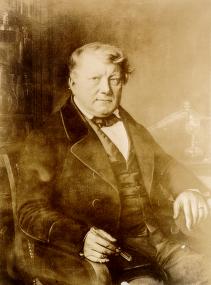Christian Friedrich Schönbein
Christian Friedrich Schönbein (18 October 1799 – 29 August 1868) was a German-Swiss chemist who is best known for his discovery of ozone and his development of gun cotton, a precursor to modern explosives and smokeless powder. His work significantly contributed to the fields of chemistry and materials science, impacting both scientific research and practical applications in industry and military technology.
Early Life and Education[edit | edit source]
Christian Friedrich Schönbein was born in Metzingen, Württemberg, Germany. Despite facing financial difficulties and limited formal education in his early years, Schönbein's keen interest in science led him to pursue a career in chemistry. He worked as an apprentice to an apothecary before moving to the University of Erlangen, where he studied chemistry. Schönbein's academic journey did not stop there; he continued his studies and research in various European cities, including Tübingen and Paris, where he was influenced by some of the leading scientists of his time.
Career and Discoveries[edit | edit source]
In 1828, Schönbein became a professor of chemistry and physics at the University of Basel, Switzerland, a position he held until his death. It was here that he made his most notable discoveries.
Discovery of Ozone[edit | edit source]
In 1840, Schönbein discovered ozone, a form of oxygen with a distinct odor, while experimenting with electrolysis and observing the smell produced during the process. He named the gas "ozone" from the Greek word ozein, meaning "to smell". This discovery was significant for the field of chemistry and had wide-ranging implications, including in the study of atmospheric chemistry and environmental science.
Development of Gun Cotton[edit | edit source]
Schönbein's other major contribution was the invention of gun cotton in 1846. By treating cotton with a mixture of nitric acid and sulfuric acid, he created a highly flammable compound that burned more cleanly and rapidly than black powder, the primary explosive used at the time. This invention revolutionized the development of explosives and had a profound impact on military technology, although it also led to several accidents due to its instability.
Later Life and Legacy[edit | edit source]
Christian Friedrich Schönbein continued his research and teaching at the University of Basel until his death in 1868. His contributions to chemistry, particularly the discovery of ozone and the development of gun cotton, have left a lasting legacy in the scientific community. Schönbein's work laid the groundwork for future research in atmospheric chemistry, environmental science, and materials science, influencing subsequent generations of scientists and engineers.
Schönbein was also known for his correspondence with other prominent scientists of his time, including Michael Faraday, with whom he discussed his discoveries and theories. These exchanges contributed to the broader scientific dialogue of the 19th century, fostering collaboration and knowledge sharing among researchers.
Conclusion[edit | edit source]
Christian Friedrich Schönbein's discoveries of ozone and gun cotton marked significant advancements in the field of chemistry. His innovative research and dedication to science exemplify the spirit of inquiry and discovery that drives scientific progress. Schönbein's legacy continues to influence contemporary research and applications in chemistry, environmental science, and materials engineering, demonstrating the enduring impact of his work.
Navigation: Wellness - Encyclopedia - Health topics - Disease Index - Drugs - World Directory - Gray's Anatomy - Keto diet - Recipes
Search WikiMD
Ad.Tired of being Overweight? Try W8MD's physician weight loss program.
Semaglutide (Ozempic / Wegovy and Tirzepatide (Mounjaro / Zepbound) available.
Advertise on WikiMD
WikiMD is not a substitute for professional medical advice. See full disclaimer.
Credits:Most images are courtesy of Wikimedia commons, and templates Wikipedia, licensed under CC BY SA or similar.Contributors: Prab R. Tumpati, MD

